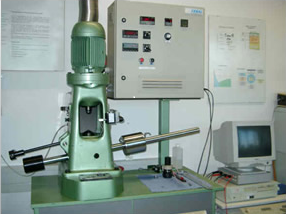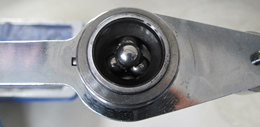Shell four-ball apparatus (VKA)

Testing in the Shell four-ball apparatus (VKA) to DIN 51 350 is used to determine characteristic values for lubricants with active ingredients that are intended to permit high surface pressure in the mixed friction area between surfaces moving relative to one another (EP additives). In addition, the wear protection behavior (AW behavior) of the lubricants can be tested at lower pressures.
Numerous special adapters allow further special measurements.
The lubricant is tested in a four-ball system consisting of a rotating ball (track ball) sliding on three balls (stationary balls) identical to it. When testing according to part 2 (oils) and 4 (greases), the test load is increased until the balls are welded together. The procedure according to parts 3 and 5 is carried out at lower loads (150 and 300 N, respectively) and is used to determine the VKA wear characteristics. If required, the frictional torque can be recorded continuously.

The test rig is widely used, especially in the lubricant and additive industries, where it is routinely used for product development and quality control.
A method developed by Volkswagen allows statements to be made about protection against pitting (VW standard PV 1444). With a separate shear adapter, the shear strength of polymer-containing lubricants to DIN 51350 Part 6 can also be tested using a tapered roller bearing.
With the aid of a (nearly) adiabatic test cup, it is possible to determine internal and external friction losses in axial deep groove ball bearings (PV 1454). This method is of particular interest for the development and investigation of light-running oils.
Using a special adapter developed at the institute, almost all plain and rolling bearings up to an outside diameter of 80 mm can be tested under axial load. In addition, for all tests, the contact resistance between the test specimens can be measured and recorded during the test.
All measurement data are stored on a PC and can be further processed with all known evaluation programs. These adapters and modifications have upgraded the VKA to a very universally applicable modern test instrument.
| Test bench parameters | ||
| Rotary speed | 10 to 5,800 1/min | |
| Load | 100 to 12,000 Newton | |
| Temperature | -20 to 150 °C | |
| Movement types | Gliding, rolling | |
| Friction conditions | Boundary and mixed friction, EHD | |
| Contact geometry | Point contact | |
| Measured variables | Wear (calotte diameter), welding force Frictional torque, lubricant temperature, contact resistance |
Standard tests
- Determination of the welding force of liquid lubricants; DIN 51350/2
- Determination of wear characteristics of liquid lubricants; DIN 51350/3
- Determination of the welding force of consistent lubricants; DIN 51350/4
- Determination of wear characteristics for consistent lubricants; DIN 51350/5
- Determination of the shear stability of polymer-containing lubricating oils; DIN 51350/6
Tests according to international standards
- Measurement of EP-Properties of Lubricating Fluids; ASTM D 2783-82
- Measurement of EP-Properties of Lubricating Grease; ASTM D 2783-82
- Wear Preventive Characteristics of Lubricating Fluids; ASTM D 4172-82
- Wear Preventive Characteristics of Lubricating Grease; ASTM D 2266-86
- EP-Properties: Friction and Wear Tests for Lubrications; IP 239 / 85
- Viscosity Shear Stability of Transmission Lubricants; CEC L-45-T-93
Other tests
- Determination of friction and wear as a function of load, temperature, sliding speed and lubricant
- Determination of the steady-state temperature and frictional torque of tapered roller and thrust ball bearings as a function of load, temperature, sliding speed and lubricant (VW PV 1454)
- Ball-on-three-plates test (BOTP)
- Pitting test (VW PV 1444)
Possible specimen geometries

